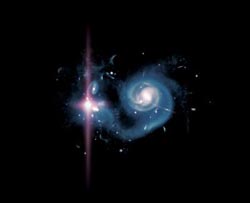Super-rare, super-luminous supernovae are likely explosion of universe's earliest stars

This is an artist's impression of a super-luminous supernova exploding in an interacting and very strongly star-forming galaxy at high redshift.<br><br>Credit: Marie Martig and Adrian Malec, Swinburne University<br>
“The objects are both unusually bright and unusually slow to fade. These are properties that are consistent with what is known as pair-instability supernova, a rare mechanism for explosion which is expected to happen for high-mass stars with almost no metal content. That is, the very first stars to form,” said Carlberg.
The two supernovae, identified as SN2213 and SN1000+2016, were discovered in image data obtained via the Canada-France-Hawaii Telescope Legacy Survey. In recent years, various surveys have enabled astronomers to open new windows on the universe, including the discovery over the past decade of super-luminous supernovae that are tens to hundreds of times more luminous than regular supernovae. “The Canada-France-Hawaii Telescope Legacy Survey stands out as the first really deep survey of the sky, covering large volumes of the universe,” said Carlberg, a Canadian leader of the Survey.
All of the processing of the image data was done at U of T using a search technique that first vastly narrows the search to the high redshift star-forming galaxies and then looks for supernovae that are more luminous than normal supernovae and have unusually long fading times — precisely the characteristics of pair-instability supernovae.
The pair-instability explosion mechanism only occurs in stars that are about 150-300 times more massive than the sun, explains Carlberg. No stars that massive form in the current universe because as stars are assembled they start nuclear burning and push away additional gas. However, in the very early days of the universe, the metal abundance of the gas is essentially zero, making it almost transparent so that it can fall on the forming star.
Such massive stars do not last long. They are so hot in the centre that pressure is lost causing a collapse to start, which then heats up the core even more. Eventually enough oxygen and silicon are created that their fusion causes a nuclear explosion much more luminous than other supernova mechanisms.
The paper, entitled “Super-luminous Supernova Discoveries at z=2.05 and z=3.90,” is published online in Nature at http://www.nature.com/nature/journal/vaop/ncurrent/full/nature11521.html and will appear in the November 8 print edition. The team also includes scientists from Swinburne University of Technology, Oxford, Wiezmann Institute of Science, University of California, Irvine and San Diego State University.
IMAGE AT: uoft.me/supernova
MEDIA CONTACTS:
Raymond Carlberg
Department of Astronomy & Astrophysics
University of Toronto
Raymond.carlberg@utoronto.ca
416-978-2198
Kim Luke
Communications
Faculty of Arts & Science
University of Toronto
Kim.luke@utoronto.ca
416-978-4352
Media Contact
More Information:
http://www.utoronto.caAll latest news from the category: Physics and Astronomy
This area deals with the fundamental laws and building blocks of nature and how they interact, the properties and the behavior of matter, and research into space and time and their structures.
innovations-report provides in-depth reports and articles on subjects such as astrophysics, laser technologies, nuclear, quantum, particle and solid-state physics, nanotechnologies, planetary research and findings (Mars, Venus) and developments related to the Hubble Telescope.
Newest articles

Silicon Carbide Innovation Alliance to drive industrial-scale semiconductor work
Known for its ability to withstand extreme environments and high voltages, silicon carbide (SiC) is a semiconducting material made up of silicon and carbon atoms arranged into crystals that is…

New SPECT/CT technique shows impressive biomarker identification
…offers increased access for prostate cancer patients. A novel SPECT/CT acquisition method can accurately detect radiopharmaceutical biodistribution in a convenient manner for prostate cancer patients, opening the door for more…

How 3D printers can give robots a soft touch
Soft skin coverings and touch sensors have emerged as a promising feature for robots that are both safer and more intuitive for human interaction, but they are expensive and difficult…





















